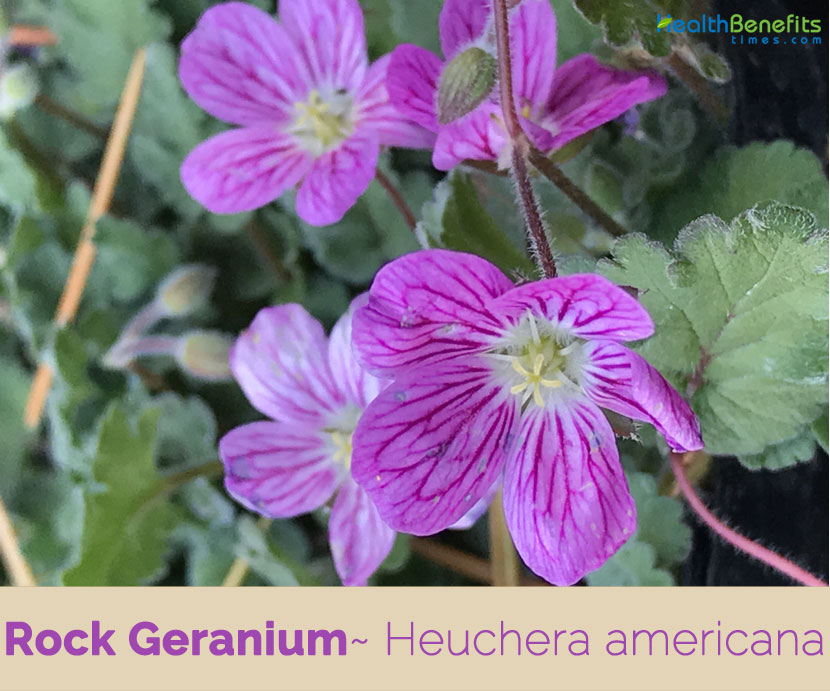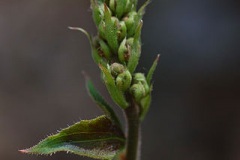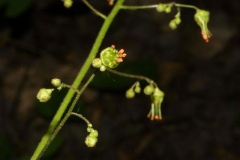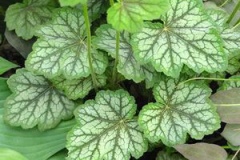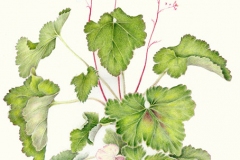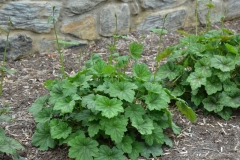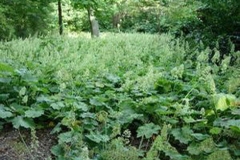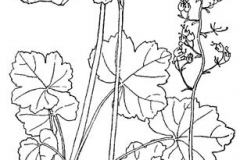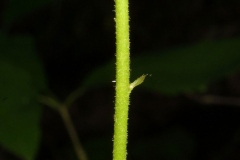Rock Geranium Facts
| Rock Geranium Quick Facts | |
|---|---|
| Name: | Rock Geranium |
| Scientific Name: | Heuchera americana |
| Origin | Eastern and central North America |
| Shapes | Ovoid capsules, 4–10.5 mm long |
| Health benefits | Cures ulcers, Combats diarrhea, Dental health, Treats bleeding cuts, Treats dysentery |
| Name | Rock Geranium |
|---|---|
| Scientific Name | Heuchera americana |
| Native | Eastern and central North America |
| Common Names | Rock Geranium, American alumroot, Alumroot, Coral Bells, Rock Geranium, American tormentil, Crowfoot, Cranesbill, Cranesbill root, Cora bells, Spotted geranium, Heuchera Americana, Alum, Storksbill, Wild cranesbill |
| Name in Other Languages | Arabic: Hushariat ‘amrikia ( هوشرية أمريكية) Czech: Heuchera krvavá Danish: Alumroot, Amerikansk Alunrod Dutch: purperklokje English: American alumroot, Rock geranium, Alumroot Finnish: Amerikankeijunkukka French: Heuchère d’Amérique, Heuchera d’Amérique German: Hohes Purpurglöckchen, Amerika-Purpurglöckchen Japanese: Myōban no rūto (ミョウバンのルート) Polish: Żurawka amerykańska Russian: Geykhera amerikanskaia (Гейхера американская) Swedish: Marmoralunrot, alunrot |
| Plant Growth Habit | More or less evergreen, clump-forming herbaceous perennials plant |
| Growing Climates | Somewhat dryish locations in rocky open woodlands, along ledges and crevices of bluffs, loamy woods and shady calcareous slopes and rocks |
| Soil | Thrives best in sandy, moist and well-drained soil. It does not grow well in soil which is water logged or in clay and it tolerates slightly acidic and basic soils also |
| Plant Size | 12 to 15 inches tall and 12 to 18 inches wide, depending on how hard the rock is they are trying to break |
| Root | Perennial, yellowish, horizontal, somewhat flattened, rough and unequal, with an intensely astringent taste |
| Leaf | Evergreen 7-9 shallowly lobed, toothed and heart-shaped basal leaves; 3-4 inches wide; each leaf has a long stalk and grows from base of plant; leaves hairy underneath |
| Flowering season | July to August |
| Flower | Small greenish-purple bell-shaped flowers drooping from short branching stems; stamens tipped with orange anthers; flowers have 5 petals, 5 sepals and 5 stamens |
| Fruit Shape & Size | Ovoid capsules, 4–10.5 mm long |
| Seed | Dark brown, ellipsoid, 0.6–0.9 mm long |
| Propagation | By seed or Can be propagated by crown division |
| Pollination | By insects and bees |
| Season | August to September |
| Health Benefits |
|
Plant description
Rock Geranium is a more or less evergreen, clump-forming herbaceous perennials plant that normally grows about 12 to 15 inches tall and 12 to 18 inches wide, depending on how hard the rock is they are trying to break. The plant is found growing in somewhat dryish locations in rocky open woodlands, along ledges and crevices of bluffs, loamy woods and shady calcareous slopes and rocks. The plant thrives best in sandy, moist and well-drained soil. It does not grow well in soil which is water logged or in clay and it tolerates slightly acidic and basic soils also. Root is perennial, yellowish, horizontal, somewhat flattened, rough and unequal, with an intensely astringent taste.
Leaves
Leaves are evergreen 7-9 shallowly lobed, toothed and heart-shaped glossy, basal leaves, 3-4 inches wide. Each leaf has a long stalk and grows from base of plant; leaves are hairy underneath. Young foliage is marbled and veined brown, maturing to deep green with copper-green shading.
Flowers and Fruits
Small greenish-purple bell-shaped flowers are drooping from short branching, slender, wiry stems extending well above the mound of leaves. Stamens are tipped with orange anthers. Flowers have 5 petals, 5 sepals and 5 stamens. Flowering normally occurs from July to August. Fertile flowers are followed by ovoid capsules, 4–10.5 mm long, beaks divergent, not papillose. Seeds are dark brown, ellipsoid and 0.6–0.9 mm long.
Health benefits of Rock Geranium
Alum root, popularly known as wild geranium or cranesbill, has been used for ages both as an antiseptic and as an astringent. Read on and find out the health benefits of the herb to your general well-being.
1. Cures ulcers
Alum root helps to cure internal cancers. Simply drink a hot cup of tea made from Alum root and consume one tablespoon every day. This will help to stop excess bleeding for quicker healing. Since it is a drying effect, consume it in moderation to prevent dehydration.
2. Combats diarrhea
Due to its drying effect, Alum root can help to treat diarrhea. Native Indians used it to treat stomach ailments. To treat diarrhea, consume a strong cup of tea made from the root and ensure you follow the instructions.
3. Dental health
Alum root has been used for years as a mouth wash for treating infections of the gums and mouth. Mouth wash is simple to make, simply chop one alum root and pour it in a bowl, then fill it with warm water. Cover it and leave it for four seven hours, then rinse it. Rinse the mouthwash/infusion several times until the symptoms disappear.
4. Treats bleeding cuts
Research show that alum roots can also help stops bleeding. Simply sprinkle Alum Root residue on the sore or bleeding cut to avoid excessive blood loss. If you continue bleeding abundantly even after applying the powder, consult a doctor.
5. Treats dysentery
Researchers suggest that Alum root can help in the treatment of dysentery. Simply have a strong cup of tea from Alum root until you feel better. However, don’t consume more than 20 cups a day.
Traditional uses and benefits of Rock Geranium
- Its medicinal uses include treatment for cholera; ulcerate colitis, dysentery, gastrointestinal conditions, Bright’s disease, diarrhea, diabetes, hemorrhage, nosebleed, excessive menstruation, bloody wounds and sores.
- Root is very astringent and has been used in the treatment of cancer and also as an external remedy in sores, wounds, vaginal discharges and ulcers.
- It is taken internally in the treatment of diarrhea, dysentery and gastric ulcers.
- It should be used with some caution since excess irritates the stomach and can cause kidney and liver failure.
- Root is harvested in the autumn and is dried for use in decoction or as a powder.
- Due to its effectiveness for bleeding it can be used as a wash or gargle for sore mouth, sore throat and bleeding gums.
- Alum powder may be put on area where there is an extracted tooth.
- Alum powder can also be used on bleeding sores to halt the bleeding and this procedure is very effective.
- The extract from this medicinal herb may be used to lessen wrinkles and toning up the skin.
- Alum root medicinal herb can be used as a douche for womb conditions.
- Strong solution of the tea may be rubbed on the nipples to dry up milk.
- An enema may be done to treat internal piles or hemorrhoids.
- The Tlingit people utilized it as herbal remedy for the treatment of inflammation of the testicles caused by syphilis disease.
- Alum root is also a very good pain reliever.
- It has been used in medicines to treat external sores and wounds and internally for various gastric ailments.
- It has also had a place as a treatment to rub on the gums of teething babies.
- Its astringency has also made it useful as an alum substitute in fixing natural dyes.
- Alum Root has been used to treat ulcers and has been found helpful in fighting the bacteria in tuberculosis.
Other Facts
- Root can be used as an alum substitute; this is a mordant that is used in fixing dyes.
- Root is rich in tannin and it has been suggested that this is the mordant.
- A good ground cover plant for the woodland garden.
- Plants should be spaced about 35 cm apart each way.
References:
https://www.itis.gov/servlet/SingleRpt/SingleRpt?search_topic=TSN&search_value=24340#null
https://pfaf.org/user/plant.aspx?latinname=Heuchera+americana
https://www.cabi.org/isc/datasheet/114789
https://www.missouribotanicalgarden.org/PlantFinder/PlantFinderDetails.aspx?kempercode=k460
https://plants.usda.gov/core/profile?symbol=HEAMA2
http://www.theplantlist.org/tpl1.1/record/tro-29100129
https://www.izelplants.com/heuchera-americana-american-alumroot.html
https://gd.eppo.int/taxon/HCHAM
https://en.wikipedia.org/wiki/Heuchera_americana
https://davesgarden.com/guides/pf/go/32339/#b


